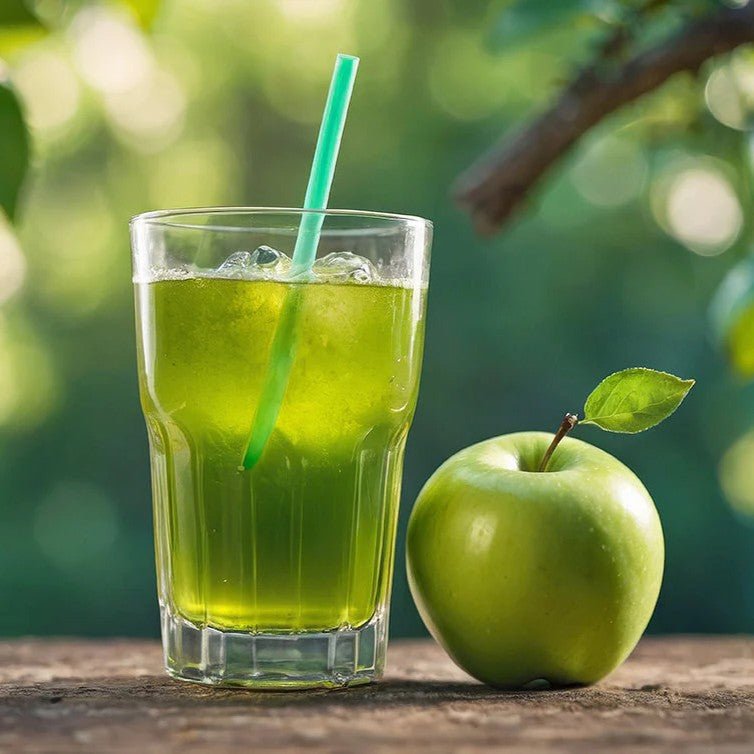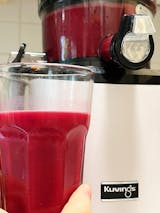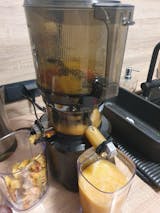Your juice guide


Getting started with juicing can be overwhelming and raise a lot of questions—but don't worry! In this post, you'll find the basics and everything you need to know about juicing.
We answer the following questions about juice and juicers:
2. How do I prepare my fruit and vegetables properly?
3. How do I create my own juice recipes?
4. How do I use my juicer effectively?
5. How long does freshly squeezed juice last?
6. How often should I drink juice?
1. Which ingredients are suitable for juicing?

You'll be surprised at how many fruits, vegetables, leafy greens, and herbs are suitable for juicing!
Here you will find a list of popular ingredients that are suitable for many recipes.
| Fruit | Vegetables |
|---|---|
|
Apples oranges pineapple Watermelon Lemons |
Carrots Beetroot celery spinach kale Ginger |
Ideal for juicing are solid, water-rich ingredients—they deliver a high juice yield and are easy to process. When selecting, consider the following:
- Firm = easy to juice
- Bright color = ripe
- Pleasant smell = ripe
- Heavy = juicy
Avoid soft or dry ingredients like bananas, avocados, or overripe fruit—they provide little juice and can clog your machine.
If you want to use juice specifically for your health, find out about suitable ingredients and consult your doctor.
2. How do I prepare my ingredients correctly?
Everyone has their own preferences when it comes to preparing ingredients—and that's a good thing! Here are some helpful tips and basic rules. Simply choose the methods that work for you.
cleaning
Wash your fruit and vegetables thoroughly—even if they're organic. This will remove any residues of pesticides or other substances.
A water bath with baking soda, vinegar or special fruit and vegetable detergent also helps with cleaning.
A vegetable brush is even more effective at removing dirt and bacteria from the peel. Check out this video from @haroldleffall to see how he cleans his fruits and vegetables.
Shell and seeds – what needs to go?
You can easily process most peels with a Kuvings juicer – provided they are clean. Exceptions are thick, fibrous, or bitter peels.
Citrus fruits are a special case: We squeeze lemons and limes with their peels, as their acidity masks the bitter taste. Oranges and grapefruits, on the other hand, should be peeled – their peels are very bitter and can make the juice inedible.
Small seeds are usually not a problem when juicing. However, large seeds or stones should be removed, as they can damage the device.
Cut
Kuvings slow juicers have a large filling opening – which means that many things fit in whole!
If your ingredients are too big, simply cut them to fit.
Fibrous ingredients like pineapple should be cut against the grain. Pineapple's grains run horizontally, so it's best to cut them into vertical strips.
3. Make your own juice recipes easily
Before we start with the recipe tips, a quick note: Is it even safe to mix fruit and vegetables?
This question comes up frequently – and yes, fruits and vegetables are digested differently, which can lead to bloating in some people.
In principle, however, it's perfectly safe to combine the two. In most recipes, fruit provides the sweetness, while vegetables balance the sugar content.
If you haven't developed your own recipes yet, start with simple combinations. With a little experimentation, you'll quickly find your favorite blends!

Start with 1-2 ingredients
Fewer, more familiar ingredients help you better assess the flavor. Once you get a feel for what goes well together, you can add more variety to your juices.
Combine ingredients with similar colors
For example, juicing celery and green grapes will produce a beautiful green juice. Mixing too many different colors, however, can result in a brownish hue—and that often looks less appetizing.
Try small amounts
It's better to prepare only 1-2 servings at a time. This way, you avoid making a large amount that you might not even like.
Tip: Make a small test juice first – if you like it, you can easily make more.
4. Juicing properly – here's how!
A juicer is easy to use – but with a few clever tips you can achieve even better results and get the most out of your fruit and vegetables.
Correct layering
If you use a hands-free juicer like the AUTO10S, we recommend the so-called layering technique:
First place soft, small and fibrous ingredients (e.g. berries, leafy greens) at the bottom of the container and then add hard and larger ingredients (e.g. carrots, apples) on top.
👉 Why? The hard ingredients help push the soft ones down. This prevents clogging and keeps the juicing process efficient.
Slow filling
With manual juicers like the REVO830 or EVO820, you should add the ingredients slowly and one at a time.
This allows the juicer to thoroughly chop and press each portion. If you fill it too quickly, the juicer may clog or work more slowly.
Another tip: Alternate between soft and hard ingredients. Ideally, finish the juicing process with a hard ingredient—this will ensure the remaining ingredients are pushed through smoothly.
💡 Example: @munching_meals added a soft tomato, then a hard carrot. One at a time, waiting until the previous one was processed. The result: A smooth, even flow of juice!
Ingredient guides
We've also created special guides for individual ingredients—e.g., celery, pineapple, leafy greens, root vegetables (like ginger & turmeric), or watermelon. Feel free to check them out!
5. How long does cold-pressed juice last?
At room temperature, you should drink fresh juice within 2 hours. It will keep in the refrigerator for up to 3 days.
Frozen juice can even last up to three months. Make sure to fill bottles only half or two-thirds full—liquid expands when frozen.
Some also use vacuum seals to slow oxidation and extend shelf life. Again, be sure not to fill to the brim to prevent liquid from being drawn into the vacuum sealer.
6. How often should I drink juice?
This varies from individual to individual – every body has its own needs. If in doubt, please consult your doctor or nutritionist.
Here are our three general recommendations:
Drink juice with meals
Replace your usual beverage with a glass of juice. Combining it with a meal allows your body to better absorb nutrients, while also providing you with fiber.
Drink juice as a snack
Feeling hungry between meals? A glass of juice is a great, healthy alternative to the classic snack—surprisingly filling, even without fiber!
One glass a day is enough
Please don't start a juice cleanse right away! Your body can react sensitively to sudden changes. Instead, start with one glass a day—this way you'll stick to it regularly without overdoing it.
We hope our tips help you get started! The more experience you gain, the more fun juicing will be. Happy juicing! 🥬🍎
This post is republished with permission from www.kuvingsusa.com


![[ Kuvings ausgezeichnet ] Präsidentenauszeichnung für regionale Innovation in Südkorea - Kuvings Deutschland](http://kuvings.de/cdn/shop/articles/kuvings-ausgezeichnet-prasidentenauszeichnung-fur-regionale-innovation-in-sudkorea-1602687.jpg?v=1762447229&width=1080)
![[ Kuvings x SV Werder Bremen ] Ein Tag voller gesunder Energie - Kuvings Deutschland](http://kuvings.de/cdn/shop/articles/kuvings-x-sv-werder-bremen-ein-tag-voller-gesunder-energie-5645597.jpg?v=1761784399&width=1080)
![[ World.einnews ] Kuvings – Premium-Entsafter, zehn Jahre Kundenzufriedenheit - Kuvings Deutschland](http://kuvings.de/cdn/shop/articles/worldeinnews-kuvings-premium-entsafter-zehn-jahre-kundenzufriedenheit-8707310.jpg?v=1759943578&width=1080)












